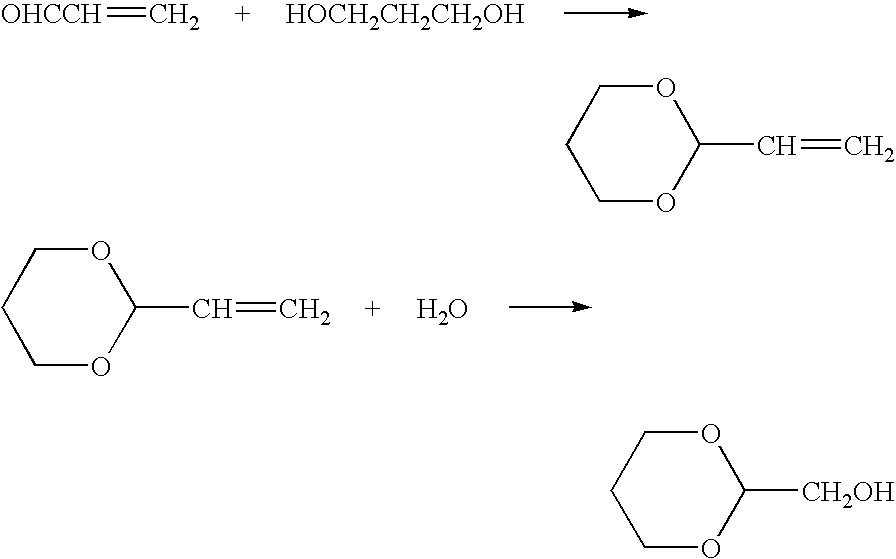Ester-forming monomer
a technology of ester-forming monomer and ester-forming monomer, which is applied in the separation/purification of carboxylic acid esters, monocomponent polyester artificial filaments, synthetic resin layered products, etc., can solve the problems of low recovery yield, inability to manufacture 3gt fibers in industrial production, and inability to establish 3gt fiber recycling techniques. , to achieve the effect of high recovery yield
- Summary
- Abstract
- Description
- Claims
- Application Information
AI Technical Summary
Benefits of technology
Problems solved by technology
Method used
Image
Examples
example 1
After charging 144 g of 3GT chips with a limiting viscosity of 0.92, 255 g (3.36 moles) of 1,3-propanediol and 144 mg of sodium acetate (0.1 wt % / polymer, indicating units of wt % with respect to the polymer weight) in a 1 L autoclave, reaction was conducted at 210° C. for 60 minutes. After the reaction, the 1,3-propanediol was distilled off under reduced pressure at 0.4 mmHg. The obtained white solid was analyzed by 1H-NMR (measuring apparatus: 400 MHz FT-NMR Model DPX-400 by Bruker Co., Ltd.) and confirmed to be bis(3-hydroxypropyl) terephthalate. The conversion rate was approximately 100%.
With 130 g of the obtained bis(3-hydroxypropyl) terephthalate there were charged 224 g (7 moles) of methanol and 25.2 g (0.24 mole) of sodium carbonate in a 1 L autoclave, and the mixture was heated at 65° C. for 30 minutes. The pH during the decomposition reaction was 12. After the reaction, the product was adequately cooled and a centrifugal separator was used at 1500 rpm to separate the liqui...
example 2
After charging 100 g of drain matter (drain waste) from extrusion of 3GT chips with a limiting viscosity of 0.9 and a moisture content of 30 ppm at 270° C., and 500 g of a 2 wt % aqueous sodium hydroxide solution in a 3 liter autoclave, hydrolysis was performed at 250° C. for 2 hours. The pH during the decomposition reaction was 13.5. No particular odor was found when the cover of the autoclave was opened.
After the reaction, the solid and liquid phases were separated and the solid phase was neutralized with dilute sulfuric acid at 0° C. to recover the terephthalic acid. The recovery yield was 80%. The acrolein content was less than 0.01 wt %, and the b value was 0.1. The liquid phase was not neutralized, and the 1,3-propanediol was isolated by distillation. The results were satisfactory with a recovery yield of 87%, an acrolein content of 0.02 wt % and a Hazen color of 5.
example 3
After charging 90 g of 3 GT chips with a limiting viscosity of 0.62, 2000 g of methanol and 90 mg of sodium carbonate in a 3 liter autoclave, the mixture was heated at 250° C. for 360 minutes. Here, the methanol was in a supercritical state. The pH during the decomposition reaction was 7.8.
After the reaction, the product was cooled and a centrifugal separator was used at 1500 rpm to recover the dimethyl terephthalate at a recovery yield of 90%. The acrolein content of the recovered dimethyl terephthalate was 0.03 wt %, and the b value was satisfactory at 0.26.
Upon distillation of the obtained dimethyl terephthalate under reduced pressure, the acrolein content of the recovered dimethyl terephthalate was 0 wt %, the b value was 0.1, and virtually no coloration was exhibited.
PUM
| Property | Measurement | Unit |
|---|---|---|
| Temperature | aaaaa | aaaaa |
Abstract
Description
Claims
Application Information
 Login to View More
Login to View More - R&D
- Intellectual Property
- Life Sciences
- Materials
- Tech Scout
- Unparalleled Data Quality
- Higher Quality Content
- 60% Fewer Hallucinations
Browse by: Latest US Patents, China's latest patents, Technical Efficacy Thesaurus, Application Domain, Technology Topic, Popular Technical Reports.
© 2025 PatSnap. All rights reserved.Legal|Privacy policy|Modern Slavery Act Transparency Statement|Sitemap|About US| Contact US: help@patsnap.com


